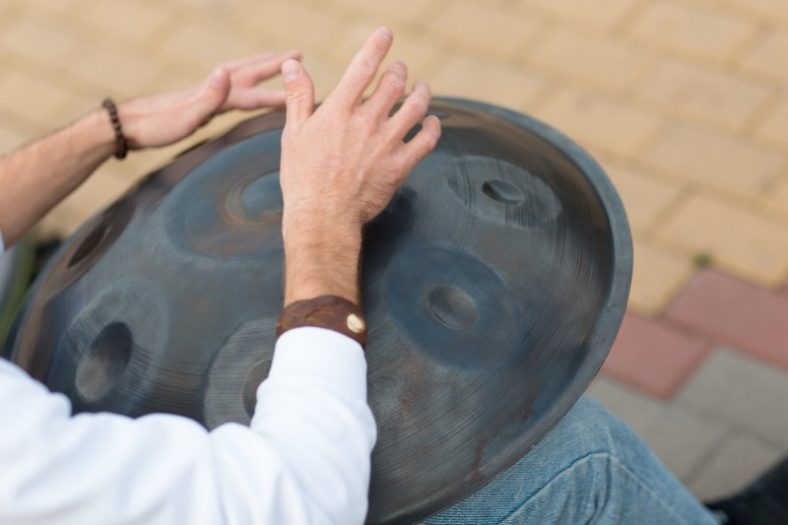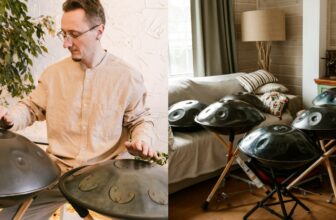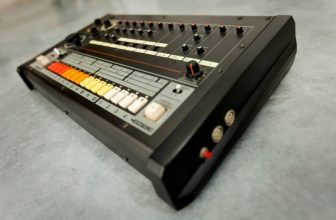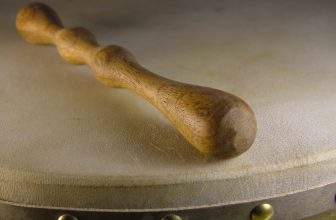Handpans – Everything You Need to Know

As one of the newest musical instruments, handpans have gained massive popularity with their ethereal, uncommon, and mystic sound. As handcrafted instruments, their shapes are also unique, which resembles a turtle shell or a UFO.
If you have ever seen or heard them somewhere, you will immediately realize what I am talking about, as these instruments are so attractive and different they are hard to forget. You may have raised curiosity about these instruments, but finding information on them to one side, even finding the name, is not easy.
As handpans are relatively newer instruments in the music world, not many people know much about these instruments, while many people have no idea at all. Plus, there are still many questions to be answered, even for novice and experienced musicians, about these instruments.
So, here is everything you need to know about handpans, commonly mistaken with the name hang drums. If you are attracted to these instruments but are unsure about handpan history, construction, price, or how and where to buy one, this guide will be the savior.
I’ve put together a separate detailed handpan buying guide as these as it can be quite tricky to figure out which ones to buy (and which scams to avoid!).
Contents
- Handpans – At a Glance
- What is a handpan?
- What is the handpan used for?
- Is the handpan a percussion instrument?
- What does the handpan sound like?
- What is the origin of the handpan?
- When was the handpan invented?
- What are the best handpan brands?
- What are handpans made out of?
- What is inside a handpan?
- Are handpans fragile?
- How many notes can a handpan play?
- What are the notes on a handpan?
- What is a mutant handpan?
- Is the handpan hard to learn?
- How do you play a handpan?
- Who are some of the famous handpan players?
- Why are handpans expensive?
- Is it called a hang drum or handpan?
- Where can I buy a handpan?
- Summary
Handpans – At a Glance
- Handpans are unique steel drum-like instruments with mesmerizing, ethereal sounds.
- Uses: Ideal for complex music, meditation, yoga, and sound healing.
- Percussion: Belongs to the idiophone family, played softly with hands.
- Unique Sound: Produces relaxing, ethereal, and resonant tones.
- Origin: Invented in 2001 as the Hang in Switzerland, inspired by steel drums.
- Materials: Made from various steel types, each influencing sound and maintenance.
- Learning: Easy for beginners, but mastering techniques takes time and practice.
- Reputable Brands: Yishama, Ayasa, Echo Sound Sculptures, and others offer top-quality handpans.
What is a handpan?
A handpan, hang, or pantam is a mesmerizing musical instrument in the shape of a convex steel drum from the idiophone family. It has a lenticular shape with two steel half-shells glued together, resembling a turtle shell or a UFO.
As handcrafted instruments, each handpan is unique. Handpan’s sound is often described as ethereal and mysterious.
Handpans, also commonly and wrongly called hang drums, space drums, and hand drums, are made of two bowls of steel glued together. The notes are located on the top of the bowls, with the center note being in the middle, which is called the Ding. Around the Ding, the tonefield is located where you find the harmonized notes.
All of the note circles feature 3 frequencies inside them with the fundamental note, the compound 5th, and the octave of the fundamental note. If you have a D note on your handpan, for example, that means the note circle has the D note as the core, A as the fifth, and another D, which is an octave higher than the core D. With the two extra harmonics tuned into a note, the instrument sounds richer, fuller and more powerful.
On the bottom shell, there is a hole called the Gu, which activates the Helmholtz resonance that gives a unique sound to the instrument. The Helmholtz resonance is a deep bass sound created by the resonant chamber inside a handpan. If this is confusing for you, you can think of the sound when blowing inside a glass bottle or putting your ear to a seashell.
With its relaxing, ethereal sounds as well as percussive qualities, handpans are quite special instruments that are played with hands. The playing style can be led by pure intuition as well as intellect with complex techniques and progressions.
It is a very easy instrument to learn and play but very complex to master. Either way, it is an ultimately fun instrument to play and experiment with.
What is the handpan used for?
A handpan is a musical instrument mainly used to play complex music with its percussive and melodic features.
Some people find its ethereal and powerful sound meditative and therapeutic, and they use it for yoga and meditation sessions as well as sound healing therapies for stress relief.
Many artists, bands, and orchestras use handpan today in their compositions. Although there are a limited number of notes on the handpan instruments, artists push their creativity to play complex melodies with different chord progressions, percussive techniques, and tricks.
Handpans are some of the rare instruments whose notes are tuned with a 1:2:3 frequency ratio. This means there are 3 frequencies on each note: the fundamental note, the compound 5th, and the octave inside them.
This sound creates a harmonizing and calming effect on human brains, making the instrument ideal for meditation, sound healing, and yoga sessions to treat many mental health issues such as PTSD, anxiety, depression, and chronic stress.
Is the handpan a percussion instrument?
The handpan belongs to the idiophone instrument family of percussion instruments. Idiophones create their sound by the vibration of the entire instrument.
Handpans are played by hand and can be used for both percussion and melody production individually or simultaneously.
While handpans are wrongly called hand drums or hang drums, they are not actually drums. Drums are membranophones, while handpans are idiophones. The way drums and handpans are played is also different, as handpans are not played with strong hits but soft touches with fingers.
Many drum and percussion players are interested in handpans and borrow their percussion techniques from different instruments, like tabla, frame drum, udu drum, and darbuka, to play handpans. This way, the handpan culture and techniques get richer, but people often wrongly use the name drum for the instrument.
What does the handpan sound like?
The handpan sounds are quite different from other instruments. It is often described as ethereal, mysterious, relaxing, and tranquil. Some others also find the sound joyful or haunting, or epic.
The scale and the notes of the handpan heavily affect how it sounds and which feeling it awakens in people.
There are many different handpans in different scales and made from different steel types. As all of these instruments are handcrafted, all have their sonic nuances. But, in general, handpans have a strong resonant sound that fills the environment.
They have a softer sound than other idiophones as they are played with hands. Every note activates other frequencies when played, which are commonly the octave and the compound 5th of the fundamental note. With the whole instrument vibration added, handpans provide a magical and rich sound.
What is the origin of the handpan?
The handpan is the newest musical instrument invented in 2001 by Felix Rohner and Sabina Schärer of the brand PANArt in Bern, Switzerland. Inspired by the steel pans of Trinidad And Tobago, they created a reversed steel drum called Hang, which could be played with hands instead of mallets.
Before the Hang, PANArt was already producing steel pans from Trinidad And Tobago. When a musician specially ordered a steel pan-like instrument that could be played with hands, PANArt used their experience to create a new instrument by reversing the steel pan, doubling the shells, slightly changing the tuning process, and closing the instrument’s bottom. A new instrument was born; Hang.
Instead of mass production, PANArt produced the instrument in small quantities for special people who had to explain why they needed the instrument with a letter. A few years later, the instrument started getting more attention, and others started producing these instruments.
One of the first was Kyle Cox of Pantheon Steel, who came up with the name handpan, as Hang was a trademark of PANArt. After 2010, many people were already producing handpans in different countries, which decided on the instrument’s name: handpan.
When was the handpan invented?
The handpan was invented by Felix Rohner and Sabina Schärer of the brand PANArt in Bern, Switzerland, in 2001 with the name Hang. They were inspired by the Caribbean steel drums. Later, other steel drum makers started producing these instruments, calling them the general name handpans.
Although the Hang was invented in 2001, steel pans, considered the father of Hang and handpans, have been around since the 1930s. The British colonists in Trinidad And Tobago banned musical instruments after a riot at the end of the 19th century. Percussion music was a big part of the culture, and the folk started experimenting with different materials like bamboo sticks, frying pans, dustbin lids, and oil drums.
These primitive steel pans became very popular and a major part of the culture, evolving into the musical instruments today as the tuned steel pans. Their popularity spread worldwide, with companies like PANArt producing them in Europe. With the inspiration from there, Hang and later handpans were born at the turn of the millennium.
What are the best handpan brands?
There are more than 200 handpan makers today. The most famous and the best ones are Yishama Pantam, Ayasa Handpan, Echo Sound Sculptures, Meraki Instruments, Symphonic Steel, Pantheon Steel, Saraz Handpans, Veritas Sound Sculpture, and Isthmus Instruments.
All of these brands offer top-quality instruments with great acoustic features. The level of sound quality is professional, and the tunings are highly stable and accurate as much as they can be. As these are all handcrafted products, experience and reliability are highly important, which is why many professional players go to these makers when looking for a new handpan.
They offer custom models, which you can order with the notes you like, as well as pre-made models. The price depends on the maker, material, amount of notes, and scale. You can message makers through their website, social accounts, or emails for price and waiting time inquiries.
Although these are the top cream makers with a long history of making high-quality instruments, many other great brands offer great products. You can search and find other handpan makers, listen to their instruments, visit their ateliers, and decide to buy one if you like them. Just be sure to listen and see the handpan before purchasing, if possible.
What are handpans made out of?
Handpans are steel instruments that can be made out of raw steel, steel-coated, nitrided steel, stainless steel, and ember steel.
All of the materials have different sonic profiles and rust-prevention degrees. The most popular choices are nitrided steel and stainless steel handpans.
Raw steel is the most primitive handpan material, with untreated steel the weakest-sounding instrument. Raw steel is also highly prone to rust and susceptible to tuning issues over time. While raw steel handpans are rarely produced anymore, they are the most affordable ones.
Steel-coated handpans are also not popular anymore, as when the surface gets a little damaged, they become highly prone to rust. Plus, the sonic capacities of these instruments are weak, and often they are less responsive than other handpans. One plus is that these instruments are lighter, making it easier to travel with them.
Nitrided steel is the most popular and traditional choice for handpan material. The steel is put through a heat-treating process to harden it, making it nitrided steel. Nitrided steel handpans are less prone to rust, but you will still need to occasionally take care of them, oiling and cleaning them.
Nitrided steel provides high volume and great percussive playing capabilities with a clear, crisp sound that delivers a bright attack. They are the best choice for players who have a more percussive approach to the instrument.
Stainless steel is a relatively new material used in handpan making. These handpans are resistant to rust, so you do not have to worry about maintenance. They have a deeper, more resonating sound with a longer sustain, making them a great choice for more melodic and meditative playing.
The latest material handpan makers started to use is ember steel, a type of stainless steel. These handpans are still rare but getting more popular day by day. They have a slightly warmer and clearer tone with a ceramic sound.
What is inside a handpan?
The inside of the handpan is empty.
Handpans are made of two steel half-shells glued together. The shells are often 1.00 mm to 1.25 mm thick shells. You can turn a handpan upside down and look at the inside of it through the bottom hole called the Gu.
Are handpans fragile?
Handpans are sensitive instruments that are easy to damage. As they are tuned with hammers to a special balance, hitting them too hard while playing, dropping something on them, or bumping them somewhere will lead the instrument to go out of tune.
You should always take good care of your handpan.
In case the handpan goes out of tune, you will have to send it to the maker for a retune. In most cases, makers can easily retune the instrument quickly. But, in extreme cases, the out-of-tune note may not be usable anymore.
You should never try to retune your handpan yourself, as tuning steel requires years of practice and experience. You might further damage your instrument to an irreversible degree.
Another important factor is rust. Like most steel instruments, handpans are susceptible to rust if your handpan is not from stainless or ember steel. To avoid rust, you should use coconut oil or a special handpan oil, like Phoenix Oil or Froglube, once every few months.
You should never leave your handpan wet or in its bag, as humidity likes closed spaces. Wipe the instrument until it’s dry. If it gets wet, always leave it open, ideally somewhere where the humidity is not too high.
If you see rust dots on your handpan, you can oil the dots and use a miracle cloth or a microfiber cloth to gently rub out the rust.
Furthermore, leaving your handpan under the sun and playing when it is hot is not a good idea, leading the instrument to go out of tune. Try to avoid direct sunlight, and in case the instrument gets hot, leave it somewhere at room temperature to cool it down before playing.
How many notes can a handpan play?
A handpan usually has 8 or 9 notes, including the center note called the Ding.
Today, makers started making handpans with more notes, placing notes on the bottom shell as well as tuning more notes on the top shell. There are handpans with up to 30 notes called the mutant handpans.
What are the notes on a handpan?
Handpans come in many different scales and notes. The most common handpan scale is the D Kurd (minor) scale. Other popular scales are Amara (Dorian), Integral (minor), Hijaz (Phrygian dominant), Equinox (minor), Pygmy (minor), and Oxalis (major). All of these scales can have different center notes.
All of these different handpan scales have different feelings. Minor scales sound more sad, gloomy, and mysterious, while major scales sound more peaceful, joyful, and happy. There are also other scales outside the minor-major group. These are exotic scales such as eastern and Asian scales like Hijaz, IshaSavita, Tarznayun, and Akebono.
The names of the scales are derived from scale modes which are variations of the scales with slight nuances. There are pentatonic scales with 5 different notes, like the Pygmy scale, hexatonic scales with 6 different notes, like Amara, and Diatonic scales with 7 different notes, like the Kurd scale.
You can choose any scale and find a handpan with any note you desire. For example, you can order a Kurd scale with the C or D center note. Most of the scales are available for many different keys.
What is a mutant handpan?
A mutant handpan is a handpan with additional notes on the top and the bottom shell.
These handpans often have more than 12 or 13 notes up to 30 notes. Some models also have more than one Ding center note for more melodic and creative possibilities.
Is the handpan hard to learn?
Handpans are easy to learn but difficult to master. Handpans do not have wrong notes as they are tuned to a single musical scale. Players do not need to know any musical theory making handpans great first instruments. With a basic sense of rhythm, they are intuitive instruments to play.
The general idea is that you need around 20 hours of practice to play the instrument properly. As you have a limited number of notes, which all are in harmonic order, it is easier to learn to play the handpan. You do not have any wrong notes that would sound out of harmony. Playing any note with a basic rhythmic feeling will result in a good melody.
While a basic intuition and rhythmic feel are enough to learn to play the instrument, you will need to push the limits with different rhythmic patterns, dynamic nuances, and techniques to be a master handpan player.
There are many techniques you can adapt to your playing, like slaps, mutes, harmonics, odd rhythmic patterns, and different chord progressions. These techniques are crucial to master the instrument and make your melodies and pieces less monotonous and more exciting.
How do you play a handpan?
Handpans are played with soft touches on the note circles of the instrument with the dab of the thumb or finger.
To play a note clearly, you should think as if you are touching a very hot surface. Immediately after the strike, you should release your finger to let the note resonate and have a clear sound.
Of course, as you master the instrument, many different techniques come into play, like slaps, mutes, harmonics, chord progressions, and different percussion techniques borrowed from other instruments. These techniques add spices to melodies to make them sound less monotonous.
Who are some of the famous handpan players?
Some of the famous handpan players and masters are Kabeçao, Yatao, David Kuckhermann, Hang Massive, Sam Maher, Alexandre Lora, and many more.
Why are handpans expensive?
Handpans are unique handcrafted instruments that can only be tuned by hand with hammer hits. A handpan takes several weeks to build, and many different techniques are used in the production. That is why the prices are relatively high.
Is it called a hang drum or handpan?
While handpan is the generally accepted and the correct name for the instrument, many people wrongly call it hang or hang drum. Hang refers to the original instrument made by PANArt, which today we know as a handpan. Hang drum is a common mistake, as people think the instrument is a type of drum.
The first handpan, Hang by PANArt, was named after the word Hang which means hand in a German dialect in Switzerland. Later, many people started calling the instruments Hang drum, hand drum, and space drum as the real name was not commonly known, and people thought it was a kind of drum.
Later, when other makers started to build instruments with more modern techniques, handpan was accepted as the general name of the instrument, as Hang was a trademark of PANArt. You can think of it this way; the name handpan is like a guitar, and Hang is Fender, a guitar brand.
Kyle Cox of Pantheon Steel was the first maker to call these instruments handpans. Pantam is also another accepted name that is often used in Israel.
Where can I buy a handpan?
To buy a handpan, you can get in touch with handpan makers through their websites, social media, or email. You can place a custom order if you want a specific scale or choose from the available scales in the shop. The waiting time is often around 2 months.
If you want to buy a handpan and need some tips and recommendations on where to start looking for, what to consider before buying, and need general guidance for the process, you can check my Handpan Buying Guide article.
Even though it is better to buy these instruments firsthand, you can also look for used ones on the internet. The second-hand market is found in a Facebook group called “SWAP and SALE (only for handpan)” Here, you can find many used handpan ads with videos and reliable sellers.
Never buy a handpan from an unknown brand through Amazon, eBay, Alibaba, or any other platform. There are many overpriced and cheaply made handpans on these platforms, which are extremely low-quality instruments that would not satisfy anybody.
To avoid getting scammed, always ask for a current video of the instrument with detailed photos. Mainly reputable handpan makers will have their name, signature, and product number engraved on the bottom shell. The tuning of the instrument is also important, so if you do not trust your ear, use a tuner to check if the notes are in tune.
https://www.facebook.com/groups/SwapandSale
https://www.symphonicsteel.com/
https://echosoundsculptures.com/
Summary
Handpans are truly amazing instruments with out-of-world, mesmerizing, ethereal sounds. It is a great joy to play them for musicians as well as non-musicians. They are great for meditation, yoga, sound healing as well as composing great pieces.
As relatively new instruments, not much is known about handpans. After this article, you are entirely ready to step into the handpan world and explore what this UFO-like unique instrument has to offer.





